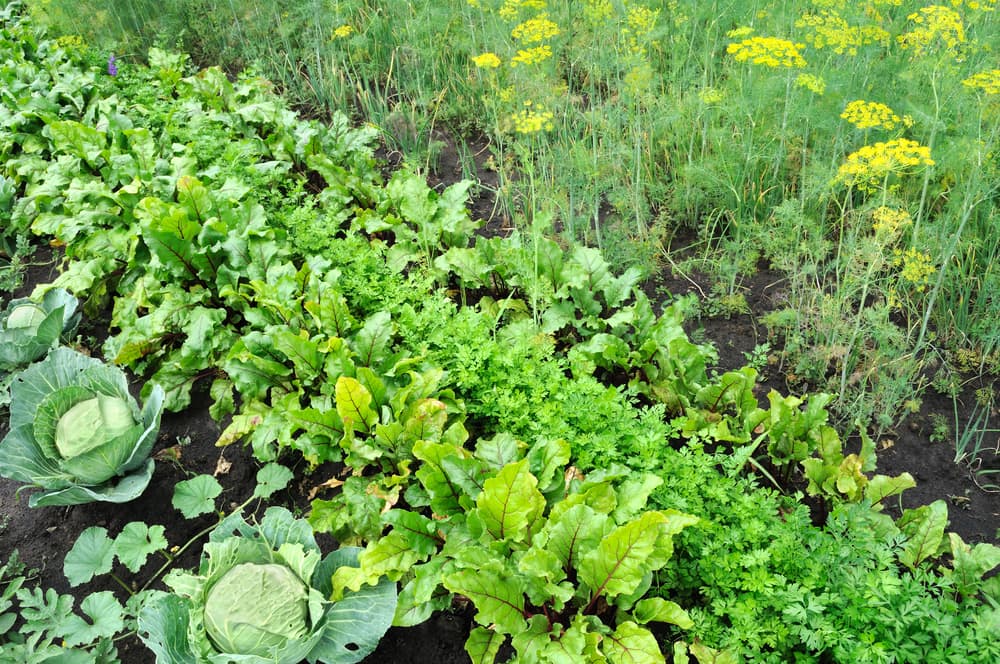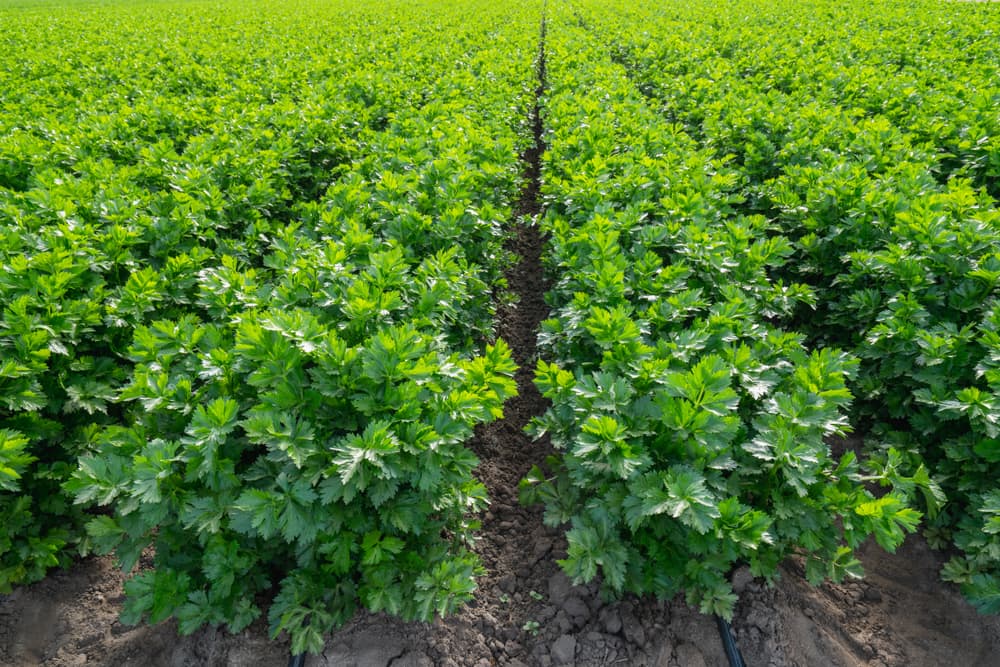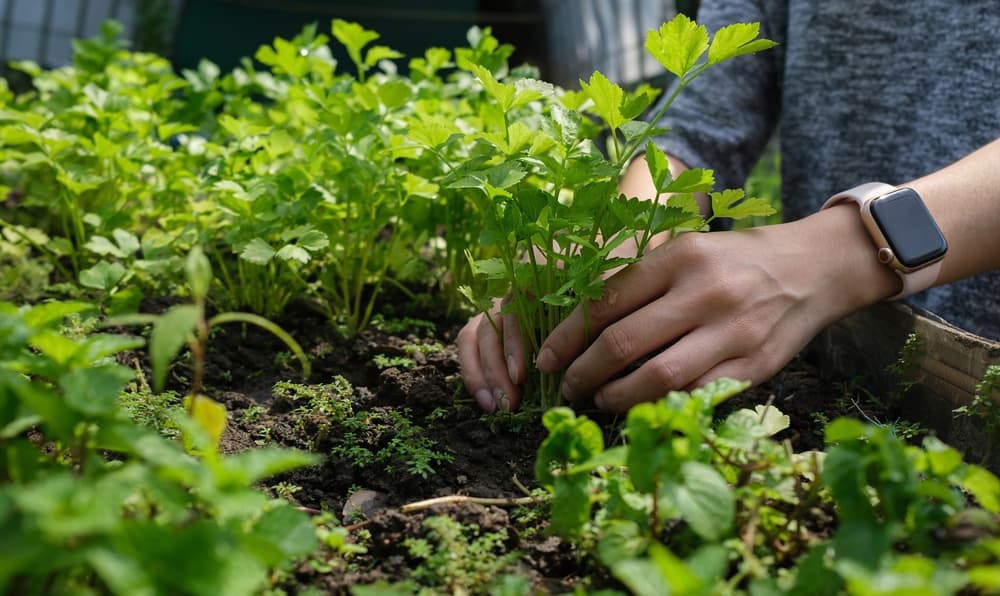Celery Varieties And Growing Methods With Permaculture Gardener Elizabeth Waddington

VEGETABLES > CELERY

Elizabeth is a Permaculture Garden Designer, Sustainability Consultant and Professional Writer, working as an advocate for positive change. She graduated from the University of St. Andrews with an MA in English and Philosophy and obtained a Diploma in Applied Permaculture Design from the Permaculture Association.
Reviewed By ROY NICOL

Roy is a Professional Gardener and Horticultural Consultant, specialising in large garden year-round maintenance and garden development. He is an RHS Master of Horticulture and uses his research in the application of no-dig methods in ornamental garden settings. Roy has been a Professional Gardener for more than six years and is a member of the Chartered Institute of Horticulture, Professional Gardener's Guild and Association of Professional Landscapers (Professional Gardener).
IN THIS GUIDE
CELERY GUIDES
Celery is not necessarily the easiest crop for novice gardeners to grow from seed, but it can be a great addition to a kitchen garden.
Whether you eat it raw, in a salad, or cooked in soups and other meals, this is a useful vegetable that can be great to add to a home-growing repertoire.
The celery that you can grow in your garden are cultivars of Apium graveolens.
This is a plant that naturally grows in marshy ground, which has been grown as a vegetable since ancient times.1Celery: A Brief History. (n.d.). University of Missouri. Retrieved March 14, 2023, from https://ipm.missouri.edu/MEG/2011/11/Celery-A-Brief-History/

The long fibrous stalks of the plants are the part most commonly eaten as a vegetable.
The leaves at the ends of the stalks are also edible, though stronger tasting, and are often used as a pot herb.2Hunt, T. (2019, July 9). Why are you throwing away your celery leaves? The Guardian. Retrieved March 14, 2023, from https://www.theguardian.com/lifeandstyle/2018/jul/14/waste-not-celery-leaves-herbs-salad
Overview
| Botanical Name | Apium graveolens |
| Common Name(s) | Celery |
| Plant Type | Vegetable |
| Native Area | Cultivated |
| Hardiness Rating | H2 |
| Foliage | Edible herb leaves |
| When To Sow (Indoors) | March, April |
| Plant Out | May, June |
| Harvesting Months | August, September, October, November |
Sunlight
Preferred
Full Sun
Exposure
Sheltered
Size
Height
0.1 – 0.5m
Spread
0.1 – 0.5m
Soil
Preferred
Most Fertile Soil Types
Moisture
Moisture Retentive
pH
Any
Celery is a biennial crop – it will usually flower and set seed only in its second year.
However it can bolt, and prematurely set seed when grown as an annual crop – the reasons for which we will discuss a little later in this article.

A related species, Apium graveolens var. rapaceum is a different vegetable known as celeriac, which is grown in the UK and across Europe for its large edible bulbs, rather than for its stalks or leaves.
Why Grow Celery?
Celery is usually an easy crop to grow (with the right knowledge) and a great inclusion for a home-grown vegetable garden.
One thing to note is that while celery can be rather challenging to grow from seed, it can also be regrown from the base of a stem, which is a quick and easy way to get started with growing your own.
We’ll cover both methods in this article.
Celery can grow well alongside many other plants typically grown in a kitchen garden – so where the right conditions can be provided, it can add to the biodiversity of your beds and be a key component of polyculture organic garden schemes.
Celery Varieties
If you decide to grow celery from seed, then one important decision that you will have to make is, of course, which variety or varieties to grow.

Some top varieties to grow include:
- ‘Celebrity’
- ‘Full White’
- ‘Galaxy’
- ‘Granada’
- ‘Lorreta’
- ‘Octavius’
- ‘Redventure’ (Cross of ‘Red Giant’ and ‘Ventura’)
- ‘Tango’ (this variety has good resistance to bolting)
- ‘Utah’
- ‘Victoria’
How To Grow Celery
Celery can be grown in containers, in raised beds, or in the ground, as long as suitable moist conditions can be provided and maintained.
Water is the most important thing when caring for celery, so it is important to choose to grow it somewhere where adequate moisture in the growing medium can be maintained.
Preferred Soil
Remember, the wild celery from which modern cultivars were derived naturally grows in marshy conditions.
Celery will thrive in full sun, in a humus-rich and moisture-retentive yet light and open soil or growing medium.

It is unfussy as to soil pH, however, and can thrive even in more extremely acid or alkaline conditions.
It is important to prepare a growing area well before planting out celery, which you will usually do sometime between late May and July.
Growing From Seed
As mentioned above, growing celery from seed can be somewhat challenging.
The main issue is that the seeds can be rather slow to germinate, and are also somewhat fussy when it comes to the environmental conditions required for germination to take place successfully.
Seeds are typically sown between mid-March and early April.
They can be direct sown where conditions allow, and in undercover growing areas of with protection, but it is best to sow them indoors or under cover, in seed trays, modules or pots.
Direct sowing reduces the risk of transplantation shock, but starting in trays, modules or pots makes it much easier to make sure that the necessary conditions for germination are met.

Celery can germinate from a minimum of 4°C, but when seeds and seedlings experience temperatures below 10°C then they can be more likely to bolt later in the season.
“As this can often be difficult to manage, it’s a good idea to minimise the risk of bolting by choosing bolt-resistant varieties such as Celery ‘Tango’,” says Roy Nicol, Master Horticulturist.
The optimal temperature range for germination is between 15-21°C.
Hold off sowing until these temperatures can reliably be maintained.
Bear in mind that germination can take some time, and seedlings may not emerge for 2-3 weeks.
- Seeds must be sown on the top of the growing medium, with just a very thin sprinkle of sieved compost or potting mix on top.
- Moisture is very important – the compost or potting mix must be consistently moist for germination to take place, and conditions must remain moist as seedlings emerge.
- Mist carefully to make sure moisture is maintained without damaging the tiny seedlings when they appear.
- Once seedlings emerge, wait patiently until they are large enough to handle, which is usually when they have several true leaves.
- Then carefully prick out each one and place them into their own individual pots or modules to grow on.
- Harden off and transplant celery into growing areas or your garden once the weather is reliably above at least 10°C.
Any shocks or chills during the early stages of the life of your celery – any issues will make it far more likely that the celery plants will bolt.
Regrowing Celery Stalks
If you are a novice gardener, you may find it challenging to grow celery successfully from seed.
If you are looking for an easier option, you should know that you can regrow celery stalks from the base of a celery that you have bought.

Place the base of the celery in a shallow bowl or saucer of water, and wait for roots to appear.
After the roots have formed, new growth will emerge from the top of the base.
You can keep refreshing the water and keep the celery in the water, or replant the celery with its new roots somewhere suitable in your garden.
Companion Planting
Celery is said to have a repellent effect on brassica pests like the cabbage white butterfly, so it can be beneficially planted alongside members of the cabbage family.
Beans, alliums (leeks, onions etc), spinach, and tomatoes are also said to grow well alongside this crop.
Pungent aromatic herbs will also help when planted close to celery – consider basil, thyme, sage, hyssop, or coriander, for example.

Avoid planting celery alongside carrots and other umbellifers, as these will be too much in competition with celery plants.
Celery Care
Watering
Water is the most important thing with celery – this cannot be stressed enough.
Make sure you water well and consistently throughout the growing season, and never allow the soil or growing medium to dry out.
Blanching
When preparing a growing area for celery, you will need to consider whether you have chosen a self-blanching variety, or will undertake work to blanch the stems as the plants grow.

Trenching is one common method for growing celery that will be blanched:
- A trench is prepared that is around 35-50cm wide and 30cm in depth.
- This trench is filled with organic matter (in autumn, or in early spring).
- Celery is then planted in a line along this trench, at a spacing of around 20-25cm.
- Then, when the stems are around 30cm tall, earth is mounded up around the stalks a bit at a time so just the tops are left exposed, thereby blocking the sun.
- Alternatively, cardboard collars can be used for blanching.
Self-blanching varieties will not necessarily require this treatment.
These types are often sown in blocks, so plants shade one another, which is enough to create the pale and tender stalks desired.
Mulching
It is a good idea to mulch with a nitrogen-rich mulch once the celery is established.
Mulches will not just add fertility but also help retain moisture and suppress weeds.
If you are growing celery in containers, you should also feed every couple of weeks with a compost tea or other balanced, organic liquid plant feed.
Pests & Diseases
“The larvae of the celery leaf mining fly feed on the leaves of celery, giving them a dried or scorched appearance,” explains Roy.
“Infestations can be prevented by covering plants with an insect-proof mesh, otherwise removing infected leaves promptly can prevent plants from being affected enough to cause stunted growth.
“The fungal infection celery leaf spot will also reduce the vigour of plants if allowed to spread, so infected leaves should also be removed promptly.”3Celery. (n.d.). Royal Horticultural Society. Retrieved May 10, 2023, from https://www.rhs.org.uk/vegetables/celery/grow-your-own
Harvesting
Celery is typically harvested between August and October and lifted before the first frosts.

Though trenching (or growing with protection in an undercover growing area) could allow you to string things out as late as mid-winter.
You can begin to harvest as soon as the plants are large enough, simply by cutting off the stalks at the base with a sharp knife.
References
- 1Celery: A Brief History. (n.d.). University of Missouri. Retrieved March 14, 2023, from https://ipm.missouri.edu/MEG/2011/11/Celery-A-Brief-History/
- 2Hunt, T. (2019, July 9). Why are you throwing away your celery leaves? The Guardian. Retrieved March 14, 2023, from https://www.theguardian.com/lifeandstyle/2018/jul/14/waste-not-celery-leaves-herbs-salad
- 3Celery. (n.d.). Royal Horticultural Society. Retrieved May 10, 2023, from https://www.rhs.org.uk/vegetables/celery/grow-your-own
